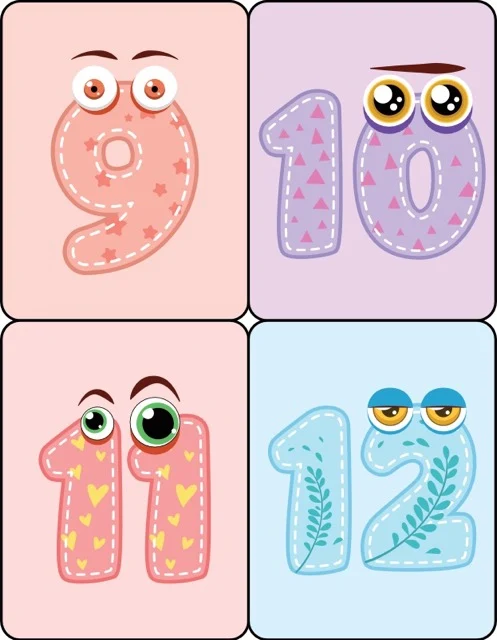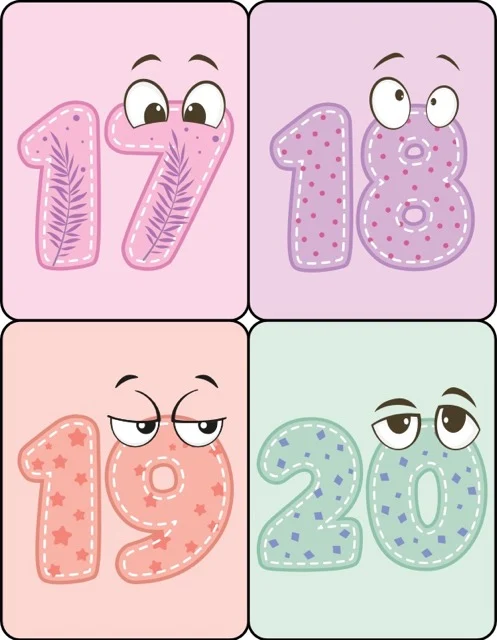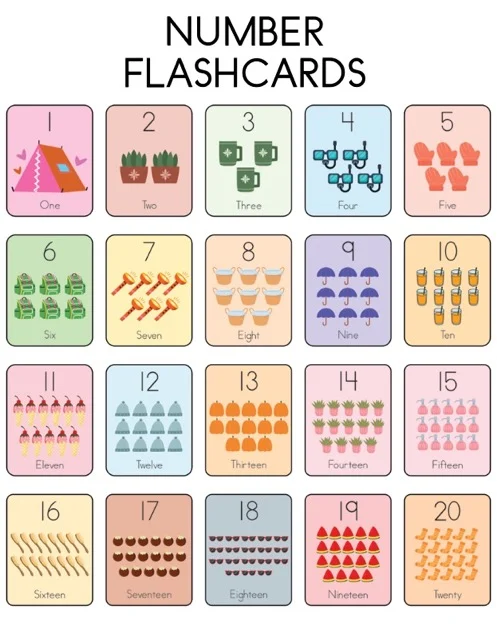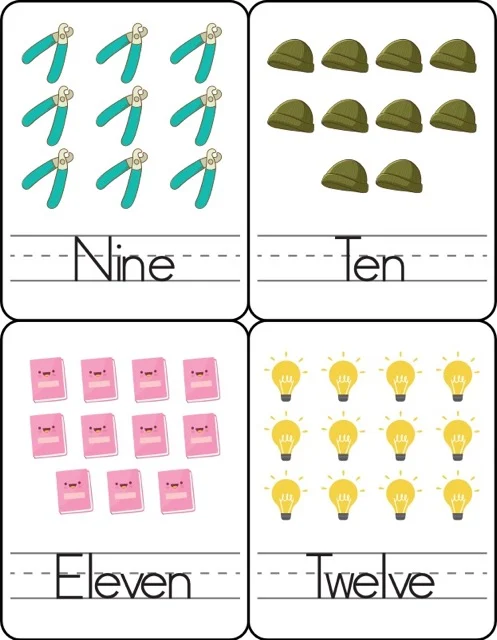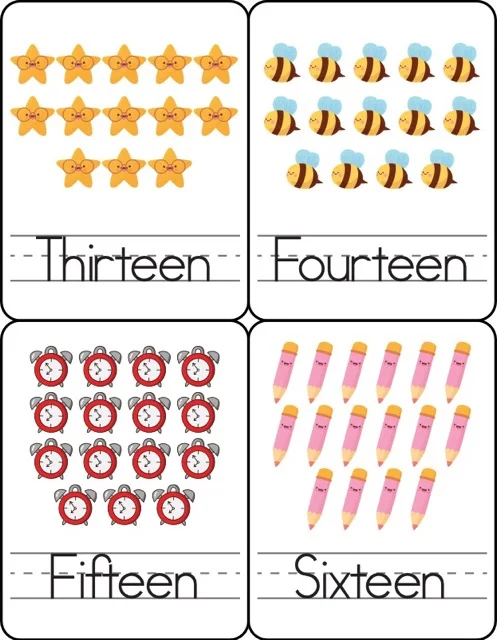Number Flashcards: A Guide to Early Math Education
This document is a guide on using number flashcards for early childhood math education. It details the benefits of flashcards, including improved number recognition and quantity association, and explores various types, such as traditional, themed, interactive, and digital options. Effective use strategies are emphasized, focusing on gradual introduction, diverse activities, regular practice, positive reinforcement, and real-life connections. The importance of visuals and parental involvement are highlighted, while acknowledging that flashcards are only one part of a broader math education approach. Finally, the document advocates supplementing flashcards with other learning methods for a well-rounded math foundation.
Number Flashcards: A Guide for Early Math Education
Number Flashcard Briefing Doc
Main Themes:
●
Number flashcards are a valuable tool for teaching young children number recognition, quantity association, and basic math skills.
●
Effective use of flashcards involves engagement, repetition, and positive reinforcement.
●
Flashcards come in various formats, allowing for diverse learning styles and preferences.
Key Ideas/Facts:
●
What are Number Flashcards?
○
Educational cards featuring numerals on one side and a corresponding quantity (objects, dots, etc.) on the other (Glossary of Key Terms).
○
Used to teach number recognition and basic math concepts.
○
Appropriate for children as young as toddlers, with complexity adjusted based on age and development.
●
Benefits of Number Flashcards:
○
Number Recognition: Help children learn to visually identify and name numerals. "They aid in number recognition helping children identify numerals..." (Short-Answer Quiz: Answer Key)
○
Quantity Association: Build a foundational understanding that numerals represent specific amounts. "They foster quantity association which connects numerals to their representative amounts." (Short-Answer Quiz: Answer Key)
○
Counting Skills: Provide practice and reinforcement of counting abilities.
○
Early Math Concepts: Introduce basic math concepts like addition and subtraction.
○
Visual Learning: Engage visual learners through visual representation.
●
Types of Number Flashcards:
○
Traditional: Numeral on one side, objects/dots on the other.
○
Themed: Feature engaging themes (animals, vehicles, etc.) to increase interest. "Besides traditional cards, there are themed flashcards (animals, vehicles)..." (Short-Answer Quiz: Answer Key)
○
Interactive: Include movable parts, flaps, or textures for tactile stimulation. "Besides traditional cards, there are... interactive flashcards with movable parts or textures." (Short-Answer Quiz: Answer Key)
○
Digital: Offer interactive features and animations in online or app formats. "Digital flashcards can offer interactive features, animations, and sounds..." (Short-Answer Quiz: Answer Key)
●
Effective Use of Number Flashcards:
○
Start small: Begin with a limited set of flashcards (e.g., 1-5) to avoid overwhelming the child.
○
Gradual progression: Introduce new numbers and concepts incrementally as the child demonstrates mastery.
○
Variety of Activities: Engage children with diverse activities such as simple identification, quantity matching, counting, sequencing, and games.
○
Regular Practice: Frequent, short sessions (5-10 minutes) are more effective than infrequent, longer ones.
○
Fun and Engaging: Use an enthusiastic tone, incorporate games, and celebrate achievements.
○
Positive Reinforcement: Praise and encourage effort, even for small successes.
○
Relate to Real Life: Connect numbers to everyday objects and situations. "By connecting numbers to objects and situations they encounter in daily life...children can see the practical application of numbers..." (Short-Answer Quiz: Answer Key)
Importance of Visuals:
●
The document "Testing Theme: Number Flashcards.pdf" showcases the visual appeal and diverse design options available in number flashcards.
●
The use of themes, colors, and different representations of quantities can enhance engagement and learning.
Parental Involvement:
●
Parents can play a vital role in supporting their child's learning with flashcards.
●
Encourage regular practice, create a positive learning environment, and connect number concepts to real-life situations.
Beyond Flashcards:
●
While valuable, flashcards alone are not sufficient for developing a comprehensive understanding of math.
●
Integrate other educational tools, hands-on activities, and real-world experiences to foster a strong foundation in early math skills.
Number Flashcards: A Comprehensive Guide
Number Flashcards FAQ
1. What are number flashcards?
Number flashcards are educational tools used to help children learn and recognize numbers. They typically feature a numeral on one side and a corresponding visual representation of the quantity on the other. This visual representation can include objects, dots, or other symbols.
2. What ages are number flashcards appropriate for?
Number flashcards can be beneficial for children of various ages, starting as young as toddlers. Simpler flashcards with bright colors and fewer objects are suitable for younger learners, while more complex cards with higher numbers and multiple representations can engage older preschoolers and kindergarteners.
3. What are the benefits of using number flashcards?
Number flashcards offer numerous benefits for young learners:
●
Number Recognition: They help children visually identify and memorize number symbols.
●
Quantity Association: Flashcards connect numerals with their corresponding quantities, building a foundational understanding of number values.
●
Counting Skills: By counting the objects on the flashcards, children practice and reinforce their counting abilities.
●
Early Math Concepts: Number flashcards introduce basic math concepts like addition and subtraction through visual manipulation.
●
Visual Learning: The visual nature of flashcards caters to visual learners and can make learning numbers more engaging.
4. How can number flashcards be used effectively?
There are various engaging ways to use number flashcards:
●
Simple Identification: Show the numeral side of the card and ask the child to name the number.
●
Quantity Matching: Display the quantity side and ask the child to identify the corresponding numeral card.
●
Counting Practice: Encourage children to count the objects on the cards aloud.
●
Number Sequencing: Arrange the cards in numerical order.
●
Games and Activities: Incorporate flashcards into games like memory matching, number bingo, or simple addition/subtraction activities.
5. What types of number flashcards are available?
Number flashcards come in diverse formats:
●
Traditional: Classic cards with numerals on one side and objects/dots on the other.
●
Themed: Flashcards featuring engaging themes like animals, vehicles, or everyday objects to enhance interest.
●
Interactive: Flashcards with movable parts, flaps, or textures to provide tactile stimulation and enhance learning.
●
Digital: Online or app-based flashcards that offer interactive features and animations.
6. How many flashcards should be used at a time?
Start with a smaller set of flashcards (e.g., numbers 1-5) to avoid overwhelming the child. As they progress, gradually introduce more cards and higher numbers.
7. How often should children practice with number flashcards?
Regular practice is key. Even short, frequent sessions (5-10 minutes) a few times a week can significantly improve number recognition and counting skills.
8. What are some additional tips for using number flashcards effectively?
●
Make it Fun: Use an enthusiastic tone of voice, incorporate games, and celebrate successes to keep children engaged.
●
Be Patient: Learning takes time and repetition. Adjust the pace to suit the child's individual learning style.
●
Provide Positive Reinforcement: Encourage and praise their efforts, even for small achievements.
●
Relate to Real-Life Examples: Connect numbers to everyday objects and situations to make learning more meaningful.
Number Flashcard Mastery: A Comprehensive Guide
Number Flashcard Mastery
Short-Answer Quiz
1.
What are two key benefits of using number flashcards with young children?
2.
Describe two distinct ways to use number flashcards for educational purposes.
3.
Explain why starting with a smaller set of flashcards is recommended.
4.
What does "quantity association" mean in the context of number flashcards?
5.
Aside from traditional number flashcards, what are two other formats available?
6.
Why is it beneficial to incorporate themes into number flashcards?
7.
How can digital number flashcards enhance the learning experience?
8.
What is the importance of relating number concepts to real-life situations?
9.
Explain the role of positive reinforcement when using flashcards.
10.
Why is regular practice with number flashcards crucial for effective learning?
Short-Answer Quiz: Answer Key
1.
Two key benefits of number flashcards: They aid in number recognition helping children identify numerals and they foster quantity association which connects numerals to their representative amounts.
2.
Two ways to use number flashcards: For simple identification, show the numeral and have the child name it. For counting practice, encourage the child to count the objects shown on the card aloud.
3.
Starting with a smaller set: A smaller set (e.g., 1-5) prevents overwhelming the child and allows them to gradually build confidence and mastery before progressing to higher numbers.
4.
Quantity association: This refers to the ability to connect a numeral (like "3") to the actual quantity it represents (three objects, dots, etc.), establishing a foundational understanding of number values.
5.
Two alternative formats: Besides traditional cards, there are themed flashcards (animals, vehicles) and interactive flashcards with movable parts or textures.
6.
Themed flashcards: Themes like animals or vehicles make learning more engaging and relatable for children, capturing their interest and enhancing their motivation to learn.
7.
Digital flashcards: Digital flashcards can offer interactive features, animations, and sounds that provide a multi-sensory learning experience, potentially making it more stimulating and enjoyable for children.
8.
Real-life connections: By connecting numbers to objects and situations they encounter in daily life (counting toys, people, etc.), children can see the practical application of numbers, making learning more meaningful and memorable.
9.
Positive reinforcement: Praising effort and celebrating successes, even small ones, builds children's confidence and motivates them to continue learning. Positive reinforcement creates a positive learning environment where children feel encouraged to try.
10.
Regular practice: Consistent, even short practice sessions reinforce the connections between numerals and quantities in the child's mind, leading to better retention and a deeper understanding of number concepts.
Essay Questions
1.
Discuss the various ways number flashcards can be integrated into playful learning activities to enhance engagement and motivation in young children. Provide specific examples of games or activities.
2.
Explain the concept of differentiated instruction in the context of using number flashcards. How can educators tailor the use of flashcards to meet the diverse learning needs and paces of individual children?
3.
Analyze the advantages and disadvantages of both physical and digital number flashcards. Consider factors such as cost, accessibility, interactivity, and potential distractions.
4.
Discuss the role of parental involvement in maximizing the effectiveness of number flashcards as a learning tool. How can parents support their children's learning beyond structured practice sessions?
5.
Critically evaluate the argument that number flashcards alone are sufficient for developing a strong foundation in early math skills. Discuss the importance of incorporating other educational tools and approaches alongside flashcards.
Glossary of Key Terms
Number Flashcards: Educational cards displaying numerals on one side and corresponding quantities (objects, dots) on the other, used for teaching number recognition and basic math concepts.
Number Recognition: The ability to visually identify and name numerals (e.g., recognizing "5" as "five").
Quantity Association: Connecting a numeral with its corresponding amount, understanding that "3" represents a group of three items.
Counting Skills: The ability to enumerate objects accurately, both verbally and mentally.
Early Math Concepts: Basic mathematical ideas like addition, subtraction, and number sequencing.
Visual Learning: A learning style where information is best understood through visual aids like pictures, diagrams, and demonstrations.
Interactive Flashcards: Flashcards with manipulative elements (flaps, sliders, textures) or digital features to enhance engagement and provide tactile/sensory input.
Themed Flashcards: Flashcards incorporating specific themes (animals, sports, occupations) to make learning more relatable and interesting for children.
Digital Flashcards: Computer-based or app-based flashcards with interactive elements, animations, and sound effects.
Positive Reinforcement: Providing praise, encouragement, or rewards to motivate and strengthen desired behaviors.
Differentiated Instruction: Tailoring teaching methods and materials to meet the individual learning styles, needs, and paces of diverse learners.



